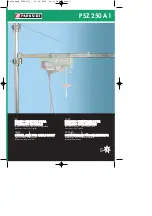
MAN16MG05
instructions
for
use
series
drh
1/2/3/4 -
dst
/
n
/
s
-
dst
/
r
-
drt
64
4.5.1 Preliminary operations
•
Lubrication of the mechanisms:
(see also point 6.3.4 “Cleaning and lubrication”)
• Ensure that there are no lubricant leaks.
• Checking the electrical system is in a suitable condition:
• Check that the travelling limit switches are installed, correctly positioned and blocked.
• Check that the voltage and line frequency, shown on the respective motor plates, correspond to those
designed for the functioning.
• Check that the voltage value to the motors is within the limits of +/- 10% of the nominal value.
• Checking the efficiency and the suitable condition of the structures for the installation of the hoist:
• Ascertain the solidity and adequacy of the structures on which the hoist is installed
• Check, in the case of the hoist with trolley, that the sliding tracks of the wheels are intact, which must be
free from obstacles, upward projecting bumps, depressions, and foreign bodies.
• Check the useful manoeuvring spaces and ascertain any potential interference
• Check that there are end catches and striker plates of the trolley limit switches
• Checking the functioning of the correct rotation direction of the motors:
• If the hoist is fitted with an electric trolley, activate the “right/left” buttons (fig. 79) and check that the
trolley moves in the corresponding directions
• Carry out the same checks on the “ascent/descent” control of the hoist taking care to make it function first
in one direction (descent) and then in the other (ascent) with two brief impulses necessary only to
ascertain the correct direction of rotation (fig. 80).
• If the direction of the movements does not correspond to the function foreseen by the button pressed,
stop the manoeuvre immediately and invert the connection of two phases of the incoming power line in
the control board or the connection of the related motors.
Before putting the DRH wire rope hoist and related trolley into use, carry out the following
operations:
4.5
Putting the machine into operation
If the rotation direction of the motors does not correspond to the controls of the push-button control
panel, the electric limit switches do not halt the movement. Consequently, when available, always
proceed first to the checking of the travelling movements and then to the checking of the lifting to
prevent dangerous situations which could occur due to the failure of the lifting limit switches.
fig. 79
fig. 80
65
instructions
for
use
series
drh
1/2/3/4 -
dst
/
n
/
s
-
dst
/
r
-
drt
MAN16MG05
4.5.2 Fitting the hook block
1. Operating at a height on the scaffold/platform or on the ground, removing the pin -2- with the related snap ring,
disconnect the lever
-L-
of the overload device -
LC-
from the anchorage cross head
-1-
, let the lever rotate
downwards
-L-
until the anchorage pivot
-3-
can be freely extracted and thus allows the anchorage to be
disassembled
-4-
(fig. 81).
2. Operating on the ground with the push-button control panel, press the descent button until the wire rope is
completely unwound, taking care not to let the descent limit switch intervene (this operation is not necessary for
hoists positioned on the ground and/or not yet installed at a height).
3. Prepare the hook block on the ground, on the perpendicular line of the hoist and insert the rope end in the hook
block according to the type of hoist (2, 4, 6 or 8 fall) as shown in the scheme.
Use if possible an iron wire temporarily fixed, with adhesive tape, to the rope end, to facilitate the operations of
passing the wire rope between the pulleys (fig. 82).
4. In the case of 4-fall hoists, provide for the geometrical arrangement of the hook block as follows (fig. 83):
• Figure 1 for hoists with drum short (C) or normal (N)
• Figure 2 for hoists with drum long (L) or extra long (X).
To fit the hook block, when it is not already fitted on the DRH hoist, proceed in the
following way:
These operations can be performed:
• At a height, with the help of suitable equipment, for hoists in fixed suspended position, or fitted with
DST/N - S or DRT trolley.
• On the ground, before installation at a height, for hoists in fixed positions which have difficulty of
access to anchorage crosshead.
fig. 83
fig. 82
fig. 81
2
2
L
3
4
1
LC
Figure 1
Figure 2
Anchorage wedge
Anchorage wedge
hook block return sheave
hook block return sheave
KMAN16MG05
Summary of Contents for DRH 1 Series
Page 128: ...KMAN16MG05...
Page 129: ......




































